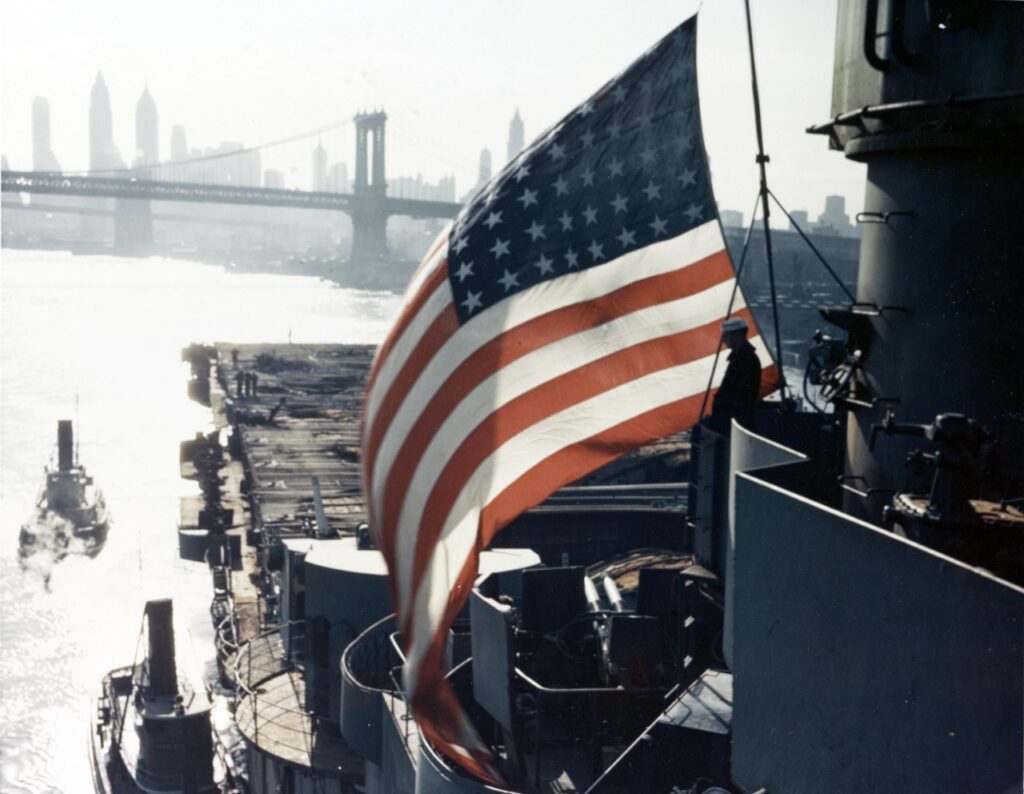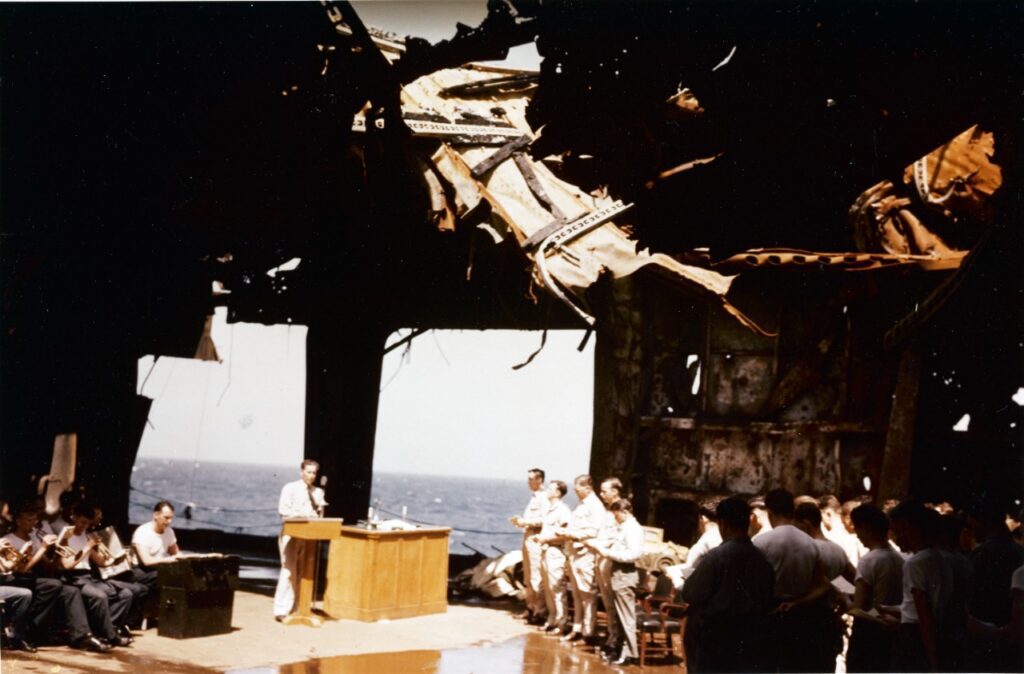Blooded But Unbowed, USS Franklin Arrives In New York

78 years ago, on 28 April 1945, USS Franklin pulled into her berth at the Brooklyn Naval Yard. Her ten thousand-mile-plus journey was over.* As was the custom with ships going to the Brooklyn Navy Yard, she spent the previous two days in nearby Gravesend Bay, unloading ammunition and unneeded fuel before she berthed at the Navy Yard. There were 962 men on board,1 less than one-third of the 3100 that sailed to Japan six weeks earlier.2 As they sighted the Statue of Liberty, many unashamedly wept.
“…SHIRKERS AND DESERTERS”
Although others wanted to accompany Big Ben to New York, Captain Leslie Gehres refused, telling them they had left the ship without permission. These were men who were blown off the ship or who had chosen the sea over the fiery hell of the flames and explosions. They had had no choice but to jump if they wanted to live. Others left believing they had received the order to abandon ship.
However, when the ship arrived at Ulithi on 24 March, the captain had to allow engineering and other crew members back on board because they needed those men’s help to help get her home. Crew member Raymond Bailey, in an oral history recorded by the National WWII Museum, recounted that when some of the men who left the ship were brought back to help run it, Captain Gehres chewed them out accusing them of “being shirkers or deserters…” Bailey went on to say that Bosun’s Mate Rufus Gentry responded, “If you don’t want me back on this damn tub, get me off this damn thing! I didn’t ask to come back!”3 The captain walked off. (Later, on 31 March, Gentry found himself appointed “Acting Chief Master-At-Arms for the voyage home.4)
704 CLUB
Captain Gehres treated the men brought back on board like outcasts. He created the “704 Club” composed of those who had never left the ship. They received wallet cards with their names and “704 Club” printed on them. However, some of the club members thought the idea was ridiculous and threw their cards away.
The ship left Pearl Harbor on 10 April and Captain Gehres kept the men busy finding and burying the dead, clearing debris, making repairs where possible, and dumping overboard damaged pieces of aircraft and the ship itself. In the April 1969 issue of the magazine, American Heritage, he wrote:
All that long voyage home, from the place where we were hit, to Ulithi, to Pearl Harbor, to Panama, to New York, I think that crew must have thought I was some kind of Simon Legree, because I worked the officers and men from sunup to sundown. As much as anything, the purpose was to keep those men busy. There were not many of them left. They had seen a great many of their shipmates die, or be burned, or blown over the side, and this was the second such experience for some of them, who had been through a kamikaze attack the previous October.
I knew if I didn’t keep them so busy that at night they would be dead tired and exhausted, that I would have a crew of mental cases by the time I got the ship home. At sundown they were just exhausted and they would drop off and go to sleep.5
19 APRIL PLAN OF THE DAY
Ten days later the ship began its transit of the Panama Canal. The ship’s crew received liberty, one half at a time. Each day, Commander Joe Taylor, the Executive Officer wrote and posted a “Plan of the Day” outlining the schedule and making announcements of interest to the crew. The 19 April Plan of the Day included a schedule listing Reveille, the meals’ schedule, various announcements, a notice of a lost wallet, and a guitar for sale. The plan also informed the men that the barber shop was set up on the fantail. “Get that haircut if you want to go ashore in Panama!”
But the first announcement was from Captain Gehres:
“The ship’s official ‘Mast Book’ was burned up on ‘Bomb Day’ and since then I have not had to hold mast or start a new book. That record, if maintained, will be the perfect finish to a heroic episode. Nothing would be a greater disappointment to me than to have to hold mast on any man now on FRANKLIN. So behave yourself in Panama as you did in Pearl Harbor. When we reach our States’ port, continue the so-far perfect record of no over-liberties, no patrol reports, no shipboard reports of shirking or neglect of duty, or troubles with petty officers. Only a perfect conduct record is becoming to a crew which could do what you have done since 0707 19 March.6
24 APRIL PLAN OF THE DAY
The 24 April Plan of the Day informed the men that as the ship passed through the Canal Zone, the crew had received many compliments on the work they had done cleaning up the ship, but “…it will take lots of work in order to make as fine an impression on New York.”
There was still a war on though, and Germany would not surrender for another nine days. The Plan also reported that a German U-boat had torpedoed a ship off Cape Hatteras the day before, “near our track.” Everyone was urged to be on the alert for submarines.
But things were loosening up. There was a volleyball tournament on the hangar deck and movies would be shown in the After Messing Compartment and Wardroom.7 And there was time for memorial services.

Finally, on 28 April, the ship pulled into her berth at the Navy Yard. The ship’s navigator, Stephen Jurika, recalled that ship traffic in the channel was heavy but Captain Gehres insisted on conning the ship himself. He turned down the help of tugs or a navy pilot “until he was headed into the berth, the nose passing over the Navy yard line, when he said, ‘It’s all yours’ and walked off the bridge.'”8
*Various sources place the distance between 10,000 and 13,000 miles.
1Joseph Springer, Inferno The Epic Life and Death Struggle of the USS Franklin In World War II (Minneapolis: Zenith Press, 2011) 307
2Clark G. Reynolds, The Fast Carriers The Forging of an Air Navy (Annapolis: Naval Institute Press, 2013) 53
3 Raymond Bailey Oral History, The National WWII Museum, https://www.ww2online.org/view/raymond-bailey#service-after-the-uss-franklin-cv-13
4USS Franklin (CV-13) Original Documents 1943-1946 31 March Plan of the Day, (Turner Publishing Company,1994) 130
5 Davidson, David , and Leslie Gehres. “BEFORE THE COLORS FADE: Leslie Gehres: Captain of the “Ship that Wouldn’t Die”.” American Heritage, April 1969. https://www.americanheritage.com/leslie-gehres-captain-ship-wouldnt-die.
6 USS Franklin (CV-13) Original Documents 1943-1946 132
7USS Franklin (CV-13) Original Documents 1943-1946134
8 Stephen Jurika, The Reminiscences of Capt. Stephen Jurika, Jr.’ USN (Ret.) Vol. II Interview with Capt. Paul B. Ryan USN (Ret.) US Naval Institute, 1979 660-661